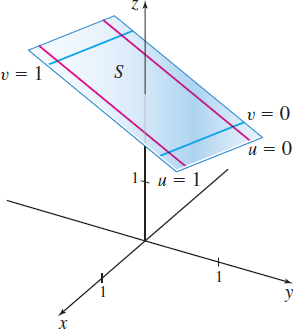EXAMPLE 1Describing a Parametric Surface
- (a) Describe the parametric surface S given by r(u,v)=(1+2u+v)i+(u−v)j+(3+v)k.
- (b) Find a rectangular equation for S.
Solution (a) We begin by finding several coordinate curves. We choose to use v=0, v=1, u=0, and u=1, but any numbers will do.
When v=0, the u-coordinate curve is r(u,0)=(1+2u)i+uj+3k.
When v=1, the u-coordinate curve is r(u,1)=(2+2u)i+(u−1)j+4k.
When u=0, the v-coordinate curve is r(0,v)=(1+v)i−vj+(3+v)k.
When u=1, the v-coordinate curve is r(1,v)=(3+v)i+(1−v)j+(3+v)k.
The graph of the parametric surface is a plane as shown in Figure 41.
(b) To find a rectangular equation for the surface, we write the components of r=r(u,v) as a system of equations. Since r=xi+yj+zk=x(u,v)i+y(u,v)j+z(u,v)k, we have{x=2u+v+1(1)y=u−v(2)z=v+3(3)
If we eliminate u and v from this system, we will have an expression involving x, y, and z. We eliminate v by adding equations (1) and (2) and equations (2) and (3). x+y=3u+1(4) Add 1 and 2.y+z=u+3(5) Add 2 and 3.
Now we eliminate u: x+y=3u+1(4) −3y−3z=−3u−9_ Multiply (5) by −3.x−2y−3z=−8Add.
This is the equation of a plane whose normal vector is i−2j−3k.
